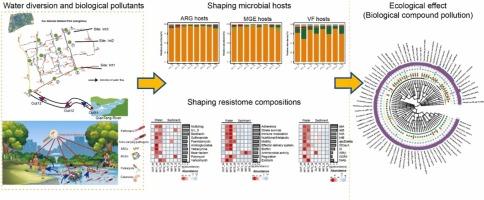Metagenomic insights into the effects of ecological water replenishment on resistome and pathogens in urban wetland
IF 11.3
1区 环境科学与生态学
Q1 ENGINEERING, ENVIRONMENTAL
引用次数: 0
Abstract
Urban wetland restoration increasingly relies on water replenishment, yet its impacts on resistome dissemination remain critically understudied. Here, we performed a comprehensive metagenomic survey of water and sediment from the Xixi National Wetland Park to investigate how water diversion from the surrounding Qiantang River affects the distribution and composition of antibiotic-resistant genes (ARGs), mobile genetic elements (MGEs), virulence factors (VFs), and pathogens. Among the detected ARGs, multidrug, macrolide-lincosamide-streptogramin, and bacitracin resistance genes were predominant. MGEs such as tnpA, IS91, and istA, and VFs involved in adherence and immune modulation were also abundant. Pathogens including Fusobacterium varium and Leptospira noguchii were frequently observed. RDA and MRM analysis revealed certain antibiotics emerged as influent factors of resistome composition. Notably, the vast majority of resistome types were shared between the wetland park and the external riverine environment, with a decline in resistome richness as distance from the water diversion source increased. This phenomenon indicates that river-to-wetland water diversion acts as a conduit, facilitating the broad dissemination of resistome components and pathogens into the wetland, while the wetland’s self-purification capacity also plays a role. Nevertheless, a small subset of ARGs and MGEs was significantly enriched within the wetland interior. Collectively, these results highlight the ecological risks of water replenishment in urban wetlands and underscores the need for mitigation strategies, such as source-water pretreatment and wetland sediment remediation.

城市湿地生态补水对抵抗组和病原体影响的宏基因组研究
城市湿地恢复越来越依赖于补水,但其对抗性群落传播的影响仍未得到充分研究。本文对西溪国家湿地公园的水体和沉积物进行了全面的宏基因组调查,探讨了钱塘江引水对西溪国家湿地公园的抗生素耐药基因(ARGs)、移动遗传因子(MGEs)、毒力因子(VFs)和病原体的分布和组成的影响。在检测到的ARGs中,多药耐药基因、大环内酯-林可胺-链状gramin耐药基因和杆菌肽耐药基因居多。tnpA、IS91和istA等MGEs以及参与粘附和免疫调节的VFs也丰富。常见致病菌包括各种梭杆菌和野口钩端螺旋体。RDA和MRM分析显示某些抗生素是影响抵抗组组成的因素。值得注意的是,绝大多数抵抗组类型在湿地公园和外部河流环境之间共享,抵抗组丰富度随着距离引水水源的距离增加而下降。这一现象表明,河流向湿地引水作为一个管道,促进了抵抗组成分和病原体在湿地的广泛传播,同时湿地的自净化能力也发挥了作用。然而,一小部分ARGs和MGEs在湿地内部显著富集。总的来说,这些结果突出了城市湿地补水的生态风险,并强调了缓解策略的必要性,如水源预处理和湿地沉积物修复。
本文章由计算机程序翻译,如有差异,请以英文原文为准。
求助全文
约1分钟内获得全文
求助全文
来源期刊

Journal of Hazardous Materials
工程技术-工程:环境
CiteScore
25.40
自引率
5.90%
发文量
3059
审稿时长
58 days
期刊介绍:
The Journal of Hazardous Materials serves as a global platform for promoting cutting-edge research in the field of Environmental Science and Engineering. Our publication features a wide range of articles, including full-length research papers, review articles, and perspectives, with the aim of enhancing our understanding of the dangers and risks associated with various materials concerning public health and the environment. It is important to note that the term "environmental contaminants" refers specifically to substances that pose hazardous effects through contamination, while excluding those that do not have such impacts on the environment or human health. Moreover, we emphasize the distinction between wastes and hazardous materials in order to provide further clarity on the scope of the journal. We have a keen interest in exploring specific compounds and microbial agents that have adverse effects on the environment.
 求助内容:
求助内容: 应助结果提醒方式:
应助结果提醒方式:


